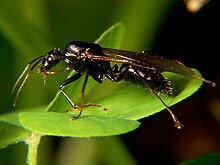This is an old revision of this page, as edited by 75.111.203.5 (talk) at 17:31, 22 July 2019 (→Behavior). The present address (URL) is a permanent link to this revision, which may differ significantly from the current revision.
Revision as of 17:31, 22 July 2019 by 75.111.203.5 (talk) (→Behavior)(diff) ← Previous revision | Latest revision (diff) | Newer revision → (diff)| This article needs additional citations for verification. Please help improve this article by adding citations to reliable sources. Unsourced material may be challenged and removed. Find sources: "Black carpenter ant" – news · newspapers · books · scholar · JSTOR (November 2013) (Learn how and when to remove this message) |
| Black carpenter ant | |
|---|---|

| |
| Camponotus pennsylvanicus (winged male) | |
| Scientific classification | |
| Kingdom: | Animalia |
| Phylum: | Arthropoda |
| Class: | Insecta |
| Order: | Hymenoptera |
| Family: | Formicidae |
| Subfamily: | Formicinae |
| Genus: | Camponotus |
| Species: | C. pennsylvanicus |
| Binomial name | |
| Camponotus pennsylvanicus (De Geer, 1773) | |

The black carpenter ant (Camponotus pennsylvanicus) is a species of carpenter ant native to central and eastern North America.
Appearance
C. pennsylvanicus can be distinguished from other carpenter ant species by the dull black color of the head and body, and by whitish or yellowish hairs on the abdomen. All castes of this species (including the major and minor workers, queens, and males) are black or blackish. Colonies' workers are not all the same size (polymorphism). The queens and the largest workers (also called super majors) are quite large and are some of the largest ants found on the North American continent. As with all ants, the antennae are elbowed. Workers usually have 12 antenna segments. Alates typically have yellowish wings.
Behavior
Black carpenter ants are known to forage up to 100 yd or 91.4 m in search of food. Workers are most active at night. They do establish chemical (pheromone) trails. The ants produce crackling sounds that can often be heard near a large nest. A large colony can contain thousands of individuals. The black carpenter ant does not sting, but the larger workers can administer a sharp bite, which can become further irritated by the injection of formic acid, which they produce. Workers tend aphids, with the smaller workers collecting honeydew and transferring it to larger workers that carry it back to the nest. In addition, foragers feed on dead insects and plant juices.
Range
The black carpenter ants range is almost everywhere east of the Rocky Mountains in woodlands, forest edges and suburban communities.
Control measures
In their natural environment, carpenter ants nest in dead trees and other dead wood. This enhances decay, which has ecological benefits. However, the ant achieves pest status when a colony invades the wood of a house or other structure, damaging its structural integrity.
Since they favor moist wood as a habitat, any condition that promotes moisture should be eliminated to prevent infestation. The easiest of these is keeping gutters clear so water does not run down the side of the structure or gain entry. Moist wood is much easier to chew. The ants do not eat the wood, but remove it to create galleries for their activities. The galleries run parallel to the grain, as they are created in the softer, nonlignin portions of the timber. The galleries have a sandpaper-like feel, due to fecal remnants, but the mud tubes produced by termites will not be present.
References
- "Black Carpenter Ant Camponotus pennsylvanicus". NWF The National Wildlife Federation. Retrieved 6 September 2018.
- http://lancaster.unl.edu/pest/resources/carpant004.shtml Carpenter Ant Management
External links
 Media related to Camponotus pennsylvanicus at Wikimedia Commons
Media related to Camponotus pennsylvanicus at Wikimedia Commons
| Taxon identifiers | |
|---|---|
| Camponotus pennsylvanicus | |